Physical Address
304 North Cardinal St.
Dorchester Center, MA 02124
Transvaginal ultrasound is usually needed for optimal assessment of the uterus.
Uterine enlargement in a nonpregnant patient is most commonly caused by fibroids or adenomyosis.
Adenomyosis should be considered when there is an enlarged globular shape of the uterus; heterogeneity or asymmetrical thickening of the myometrium; indistinct interface between the endometrium and myometrium; or cysts, echogenic striations, or echogenic nodules in the myometrium.
Leiomyosarcomas of the uterus overlap in appearance with much more common leiomyomas and are difficult to diagnose by ultrasound.
If an intrauterine device (IUD) is low in the uterus, one should suspect that one or both arms of the IUD are embedded in the myometrium.
Assessment of the fundal contour of the myometrium and endometrium in the coronal plane using three-dimensional (3-D) ultrasound is important for diagnosing the most common müllerian duct anomalies.
Infrequently the endometrium will not be fully seen on ultrasound; when this occurs, one should state that it cannot be reliably measured.
Sonography plays an integral role in evaluation of the uterus. Both transabdominal sonography (TAS) and transvaginal sonography (TVS) are well-established techniques for assessing the enlarged uterus and patients with abnormal vaginal bleeding. The anterior surface of the uterine fundus and body is covered by peritoneum. The peritoneal space anterior to the uterus is the vesicouterine pouch, or anterior cul-de-sac. This space is usually empty, but it may contain small bowel. Posteriorly, the peritoneal reflection extends to the posterior fornix of the vagina, forming the rectouterine recess, or posterior cul-de-sac. Laterally, the peritoneal reflection forms the broad ligaments, which extend from the lateral aspect of the uterus to the lateral pelvic side walls ( Fig. 15.1 ). The round ligaments arise from the uterine cornua anterior to the fallopian tubes in the broad ligaments, extend anterolaterally, and course through the inguinal canals to insert into the fascia of the labia majora.
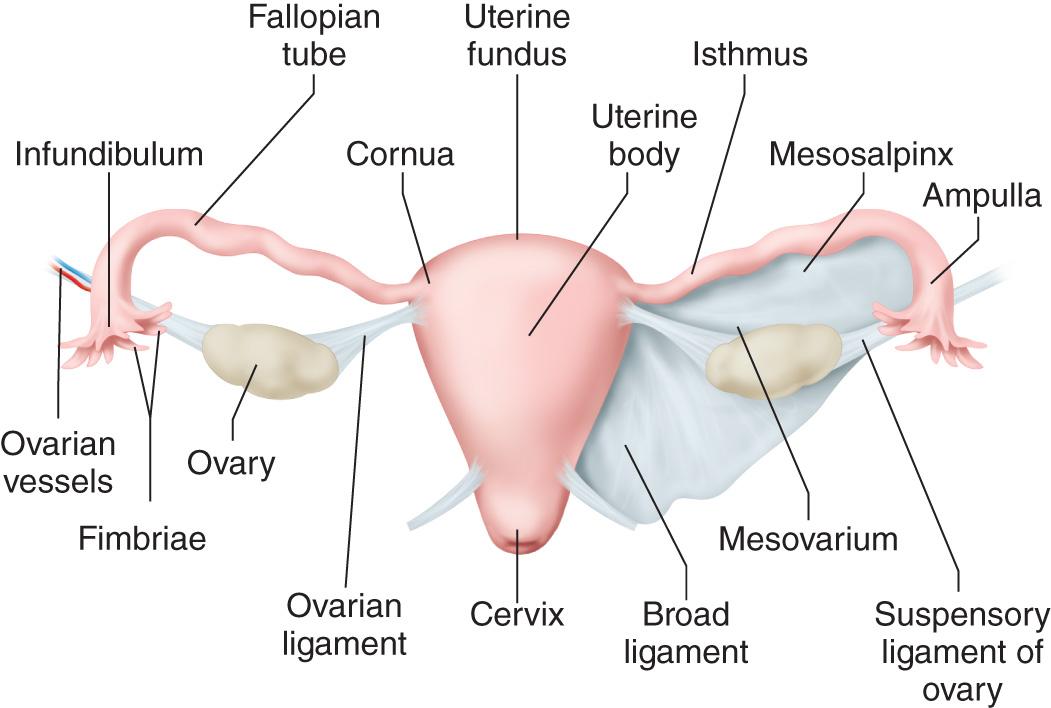
The cervix is located posterior to the bladder and opens into the upper vagina through the external os. The vagina is a fibromuscular canal that lies in the midline and runs from the cervix to the vestibule of the external genitalia. The cervix projects into the proximal vagina, creating a space between the vaginal walls and the surface of the cervix called the vaginal fornix.
The arterial blood supply to the uterus comes primarily from the uterine artery, a major branch of the anterior trunk of the internal iliac artery. The uterine artery ascends along the lateral margin of the uterus in the broad ligament and, at the level of the uterine cornua, runs laterally to anastomose with the ovarian artery. The uterine arteries anastomose extensively across the midline through the anterior and posterior arcuate arteries, which run within the broad ligament and then enter the myometrium. The uterine plexus of veins accompanies the arteries.
The uterus is usually best imaged with TVS, with as high a frequency as possible that also allows sound to adequately penetrate the uterus. However, scanning with TAS is often helpful when the uterus is enlarged and/or fibroids are located very superiorly or laterally; in such instances TVS alone may miss important findings. Thus it is important to look, albeit sometimes briefly, with TAS regardless of the degree of fullness of the urinary bladder.
Use of higher-frequency transducers with better resolution
Examination of patients who are unable to fill their bladder
Examination of obese patients
Evaluation of a retroverted or retroflexed uterus
Better characterization of the internal characteristics of a pelvic mass
Better detail of a pelvic lesion
Better detail of the endometrium
Doppler ultrasound evaluation, most often with conventional color Doppler or power Doppler, is helpful in some patients. It can be used to evaluate for the presence of vascular flow and in select cases can provide an assessment of the degree and character of vascularity. As true for any application of color or power Doppler imaging, small pixels of color that are not part of a distinct vessel should have spectral Doppler evaluation to distinguish arterial or venous flow from noise.
Three-dimensional ultrasound (3-D ultrasound), usually performed with a transvaginal transducer, is most useful for evaluating müllerian anomalies of the uterus and for assessment of abnormal position of an intrauterine device (IUD). 3-D ultrasound may also be helpful in other instances such as defining the relationship of uterine lesions to the endometrial cavity and may be useful to document findings during sonohysterography (SHG).
Sonohysterography can provide assessment of endometrium or submucosal myometrial lesions, by distending the endometrial cavity. Most studies on infusion techniques have used sterile saline. However, gel infusion is now also being used at some centers. SHG is not routinely needed but may be helpful if the endometrium is not adequately evaluated by TVS or TAS and may also be helpful in women with abnormal bleeding when a focal lesion is not visualized sonographically. Other indications may include evaluation of endometrial or intracavitary abnormalities detected by TVS, infertility, suspected congenital uterine malformations, and evaluation of women taking tamoxifen.
The procedure involves placement of a sterile speculum, cleansing of the external cervical os with an aseptic solution, and placement of a sterile catheter through the cervix into the endometrial cavity. Several catheters are available, including some with a balloon (to help prevent leakage of the saline back out the cervix) and some without a balloon. If a balloon catheter is used, it should also be filled with saline, as using air may obscure part of the endometrium. Once the speculum has been removed and the transvaginal transducer inserted, sterile saline is slowly injected during ultrasound observation while fully scanning the entire endometrial cavity. If a balloon catheter is used, one should be careful that it does not obscure part of the endometrium; this generally requires deflation of the balloon at the end of the procedure. For premenopausal women, SHG should generally be performed at about day 4 to 10 of the menstrual cycle, when the patient is no longer bleeding but is still early in the menstrual cycle when the endometrium tends to be thin, allowing for avoidance of normal changes in the latter part of the menstrual cycle that can simulate pathology. In postmenopausal women receiving sequential hormone replacement therapy (HRT), SHG is performed shortly after the monthly bleeding period. In postmenopausal women not receiving HRT, the procedure can be performed at any time. SHG should not be performed in patients who are pregnant or who have acute pelvic inflammatory disease. Prophylactic antibiotics may be considered in some women, such as those with chronic pelvic inflammatory disease, including those in whom a hydrosalpinx is discovered at the time of the study.
Other sonographic methods are used infrequently. Transrectal ultrasound may occasionally be useful to evaluate portions of the uterus if TVS is inadequate, if the patient is a virgin, or if additional imaging is needed for better assessment of the endometrium or pelvic floor. Translabial or transperineal scanning, although helpful for abnormalities of the pelvic floor, is rarely useful to evaluate the uterus in a nonpregnant patient. Use of intravenous ultrasound contrast agents to evaluate the uterus is still in its infancy but there are possible applications in such areas as endometrial lesions. Elastography could potentially help in the evaluation of fibroids, adenomyosis, or sarcomas. Both of these techniques need further investigation before routine clinical use.
The uterus is typically divided into at least three sections anatomically, although precise boundaries may be difficult to determine with ultrasound. The fundus of the uterus is the most superior portion of uterus, often defined as that portion superior to the ostia of the fallopian tubes. The body of the uterus is the largest portion and lies between the fundus and the cervix. The term “isthmus” or “lower uterine segment” is sometimes used, usually referring to the region where the body of the uterus becomes slightly thinner just superior to the cervix. The cervix is the inferior portion of the uterus between the external cervical os and internal cervical os. The internal cervical os is often difficult to precisely locate in the nonpregnant uterus.
The position of the uterus is variable and can change with the degree of bladder and/or rectal distension ( Fig. 15.2 ). It may also change during the course of the ultrasound examination in response to pressure from the transvaginal transducer or pressure from the examiner's hand on the lower abdominal wall. The term “version” is used to describe the sagittal axis of the cervix with respect to the sagittal axis of the vagina. The term “flexion” is used to describe the sagittal axis of the uterine body with respect to the sagittal axis of the cervix. These are usually subjective determinations; objective criteria have been suggested but are not widely accepted. The direction of flexion and version are usually the same and the uterus is most frequently anteverted and anteflexed. Anteverted, retroflexed position has been associated with prior cesarean section. Occasionally the sagittal axis of the uterus is the same as the sagittal axis of the vagina. Such a position usually limits TVS evaluation of the uterus. Variable terms have been used to describe this latter position of the uterus, including “axial,” “vertical,” “midposition,” or “partly retroverted.” One can try to change the uterine position by moving the transducer into the anterior or posterior vaginal fornix and applying gentle pressure with the transducer and/or the nonscanning hand on the lower abdominal wall.
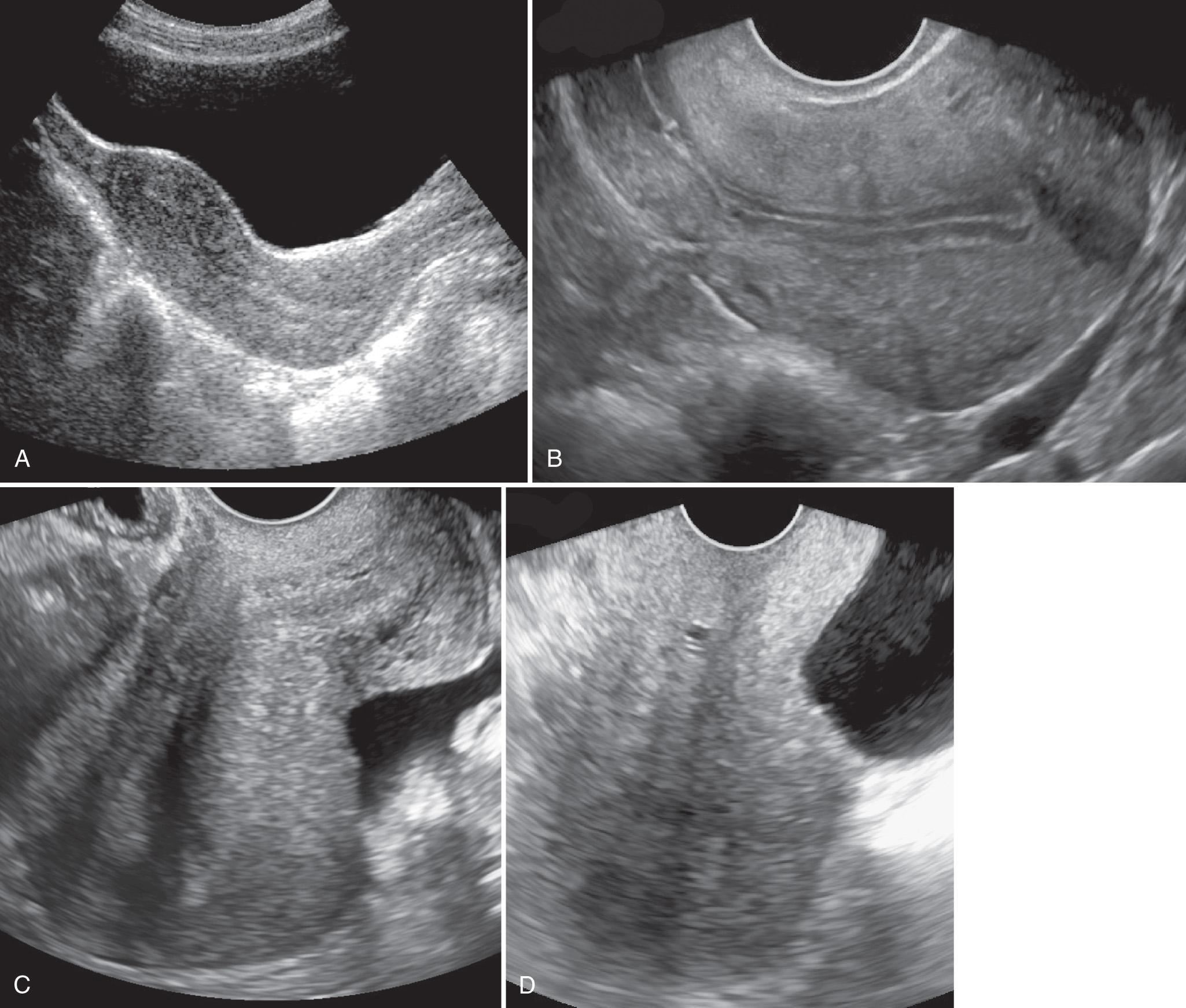
Uterine size varies depending on patient age and gravidity. In nulliparous adult women, a normal uterus has a pear-shaped appearance, with the diameter and length of the body about double that of the cervix. In general, it measures less than about 8 cm in length, 5 cm in width, and 4 cm in anteroposterior (AP) diameter. Parity (pregnancy) can increase the normal size by 1 to 2 cm in each dimension. After menopause the uterus atrophies, with the most rapid decrease in size occurring in the first 10 years after cessation of menstruation. In patients older than 65 years, the uterus ranges from 3.5 to 6.5 cm in length and 1.2 to 1.8 cm in AP diameter.
In premenopausal patients the endometrium varies in appearance and thickness during the menstrual cycle ( Fig. 15.3 ). The endometrium is composed of a superficial functional layer and a deep basal layer. The functional layer thickens throughout the menstrual cycle and is shed with menses. The basal layer remains intact during the cycle and contains the spiral arteries, which become tortuous and elongated to supply the functional layer as it thickens. The proliferative phase of the cycle before ovulation is under the influence of estrogen, whereas progesterone is mainly responsible for maintenance of the endometrium in the secretory phase following ovulation.
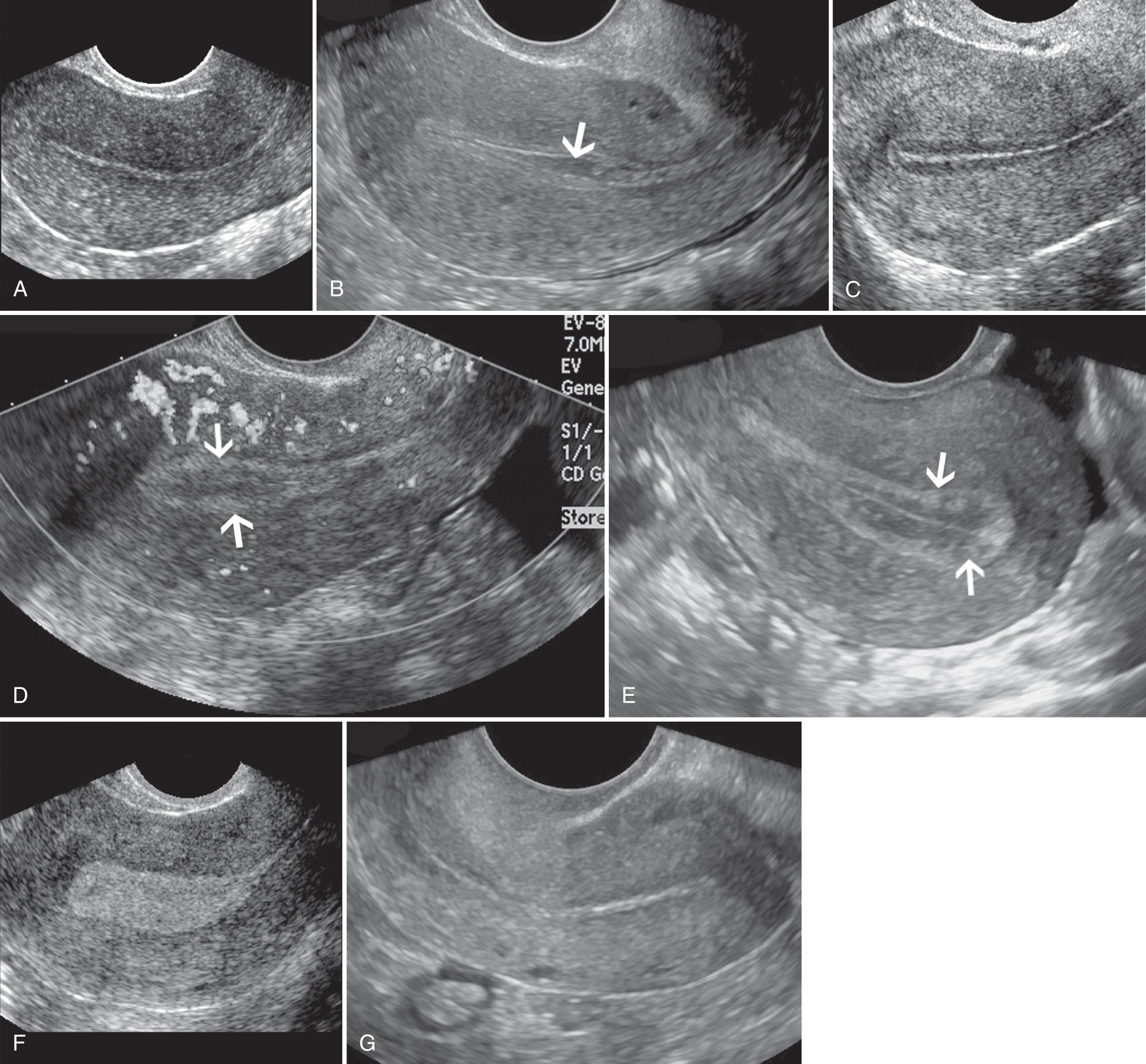
When obtaining an endometrial thickness measurement, one should make the measurement in the sagittal plane of the uterus, perpendicular to the long axis of the endometrium, at the endometrium's thickest point, including both the anterior and posterior layers. If fluid is present in the endometrial cavity, it should be excluded from the measurement. If one cannot see the entire endometrium, which may occur in up to 10% of patients, a thickness measurement should not be reported and instead one should report that it cannot be reliably measured. Such limited assessment of the endometrium may occur for various reasons including fibroids, marked obesity, and uterine position. SHG may be helpful in these patients.
During the menstrual phase the endometrium is usually a thin hyperechoic line but may be irregular or contain a small amount of fluid from blood. During the proliferative phase the endometrium thickens slightly, and later in the proliferative phase develops a multilayered appearance, also known as trilaminar or triple layer. This appearance is due to the thin echogenic line centrally that represents the opposed endometrial mucosal surfaces, the functional layer of the endometrium that becomes relatively hypoechoic, and a thin echogenic outer line. The thin echogenic outer line may be the basal layer of the endometrium or the interface between the endometrium and the myometrium. One potential pitfall in measuring the endometrium is to mistake the hypoechoic inner myometrium as part of the endometrium. One can usually make the distinction because the multilayered appearance of the proliferative phase has a distinct outer echogenic line, whereas the hypoechoic inner myometrium has no such defining outer echogenic line. After ovulation, in the secretory phase the functional layer of the endometrium becomes hyperechoic, usually starting on the outer edge and progressing inward. It generally becomes uniformly hyperechoic by the mid to late secretory phase. The endometrium tends to have more distal acoustic enhancement in the secretory phase, which can potentially be mistaken for the endometrium itself when the endometrium is poorly seen. The secretory endometrium may measure up to 16 to 20 mm (though there is no accepted upper limit of normal), and the appearance may be heterogeneous. One may occasionally see endometrial folds that can simulate polyps during the secretory phase. One should be cautious before diagnosing polyps or an abnormally thick endometrium during this phase of the menstrual cycle and consider follow-up ultrasound in the proliferative phase.
In postmenopausal women the endometrium is normally homogeneously hyperechoic in appearance. In postmenopausal women without vaginal bleeding, the upper limit of acceptable thickness is 8 to 11 mm. It should be noted that these limits are greater than expected for an atrophic endometrium and that polyps or hyperplasia could be present. However, because cancer tends to bleed early, this higher threshold in postmenopausal women who are not bleeding is acceptable in order to limit the number of endometrial biopsies for benign disease. When there is abnormal vaginal bleeding, the upper limit of normal thickness is based on the trade-off between sensitivity and specificity, and thresholds of 3 to 5 mm have been suggested. These are described in more detail in the section on endometrial bleeding.
The myometrium is normally homogeneous in echogenicity. The normal myometrium consists of three layers, although they are not distinctly separated from one another. The intermediate layer is the thickest and has a uniformly homogeneous texture of low to moderate echogenicity. The inner layer of myometrium is thin, compact, and relatively hypovascular. This inner layer, which is hypoechoic and surrounds the relatively echogenic endometrium, has also been referred to as the subendometrial halo. It should be noted that this is not necessarily the same as the junctional zone on magnetic resonance imaging (MRI). The thin outer layer is slightly less echogenic than the intermediate layer and is separated from it by the arcuate vessels.
The arcuate arteries lie between the outer and intermediate layers of the myometrium and branch into the radial arteries, which run in the intermediate layer to the level of the inner layer. The radial arteries then branch into the spiral arteries, which enter the endometrium and supply the functional layer. The uterine veins are larger than the accompanying arcuate arteries and are frequently identified as small, focal anechoic or hypoechoic areas on both TAS and TVS. These veins can occasionally be prominent and simulate cystic areas ( Fig. 15.4 ). Although Doppler imaging may be helpful in confirming the vascular nature of these spaces, the flow may be too slow to be detected by color Doppler imaging. Power Doppler imaging may be helpful in this instance; however, observation of these spaces with real-time gray-scale imaging, perhaps with increased gain settings, will usually show the movement of echoes in these veins with slow flow, confirming their vascular nature. Small calcifications may be present in the outer myometrium ( Fig. 15.5 ), thought to be in arcuate arteries, and are most commonly seen in postmenopausal women. Although it has been suggested that these calcifications might be more common in women with systemic diseases such as diabetes mellitus and renal failure, the literature thus far describes only a small number of patients. The peripheral location and diffuse linear nature of these vascular calcifications should help distinguish them from calcified fibroids.
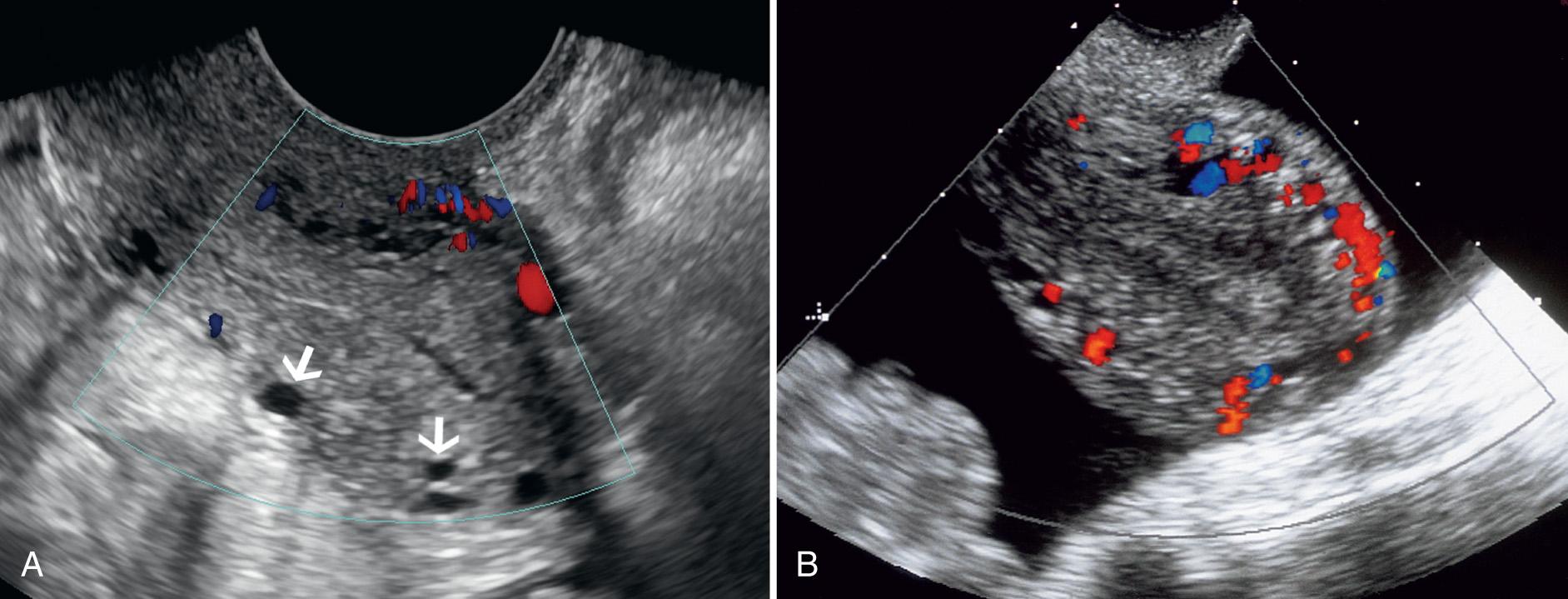
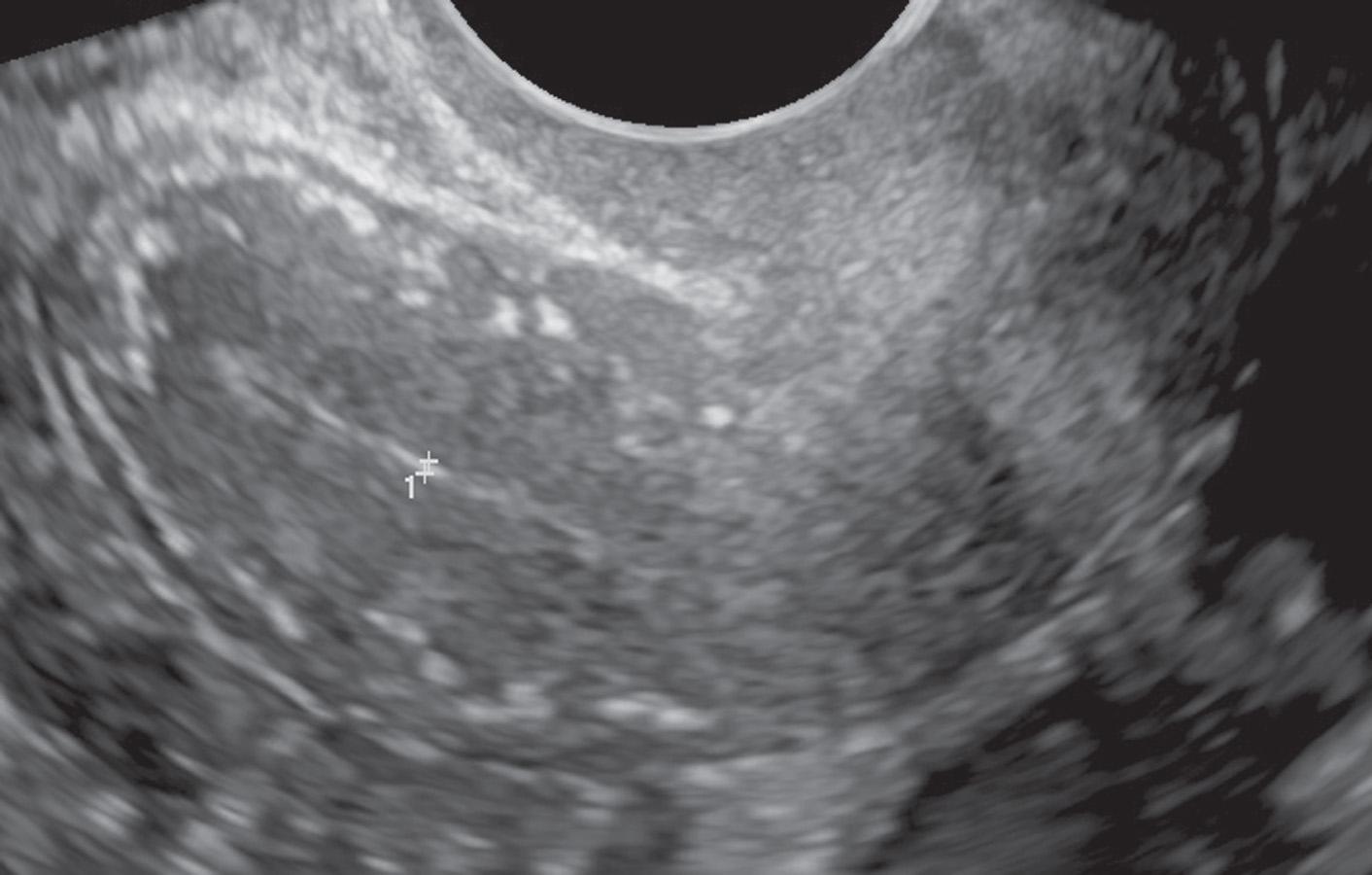
Myometrial contractions, although more commonly seen during pregnancy, can occasionally be seen in the inner myometrium of nonpregnant women. However, these are subtle contractions and in general not as large or as likely to be mistaken for pathology as may occur during pregnancy.
Tiny echogenic foci, often without acoustic shadowing, may be present in the inner myometrium near the endometrial/myometrial interface ( Fig. 15.6 ). Few data are available for this finding, but it seems to be of no clinical importance and may be due to dystrophic calcification related to prior uterine instrumentation.
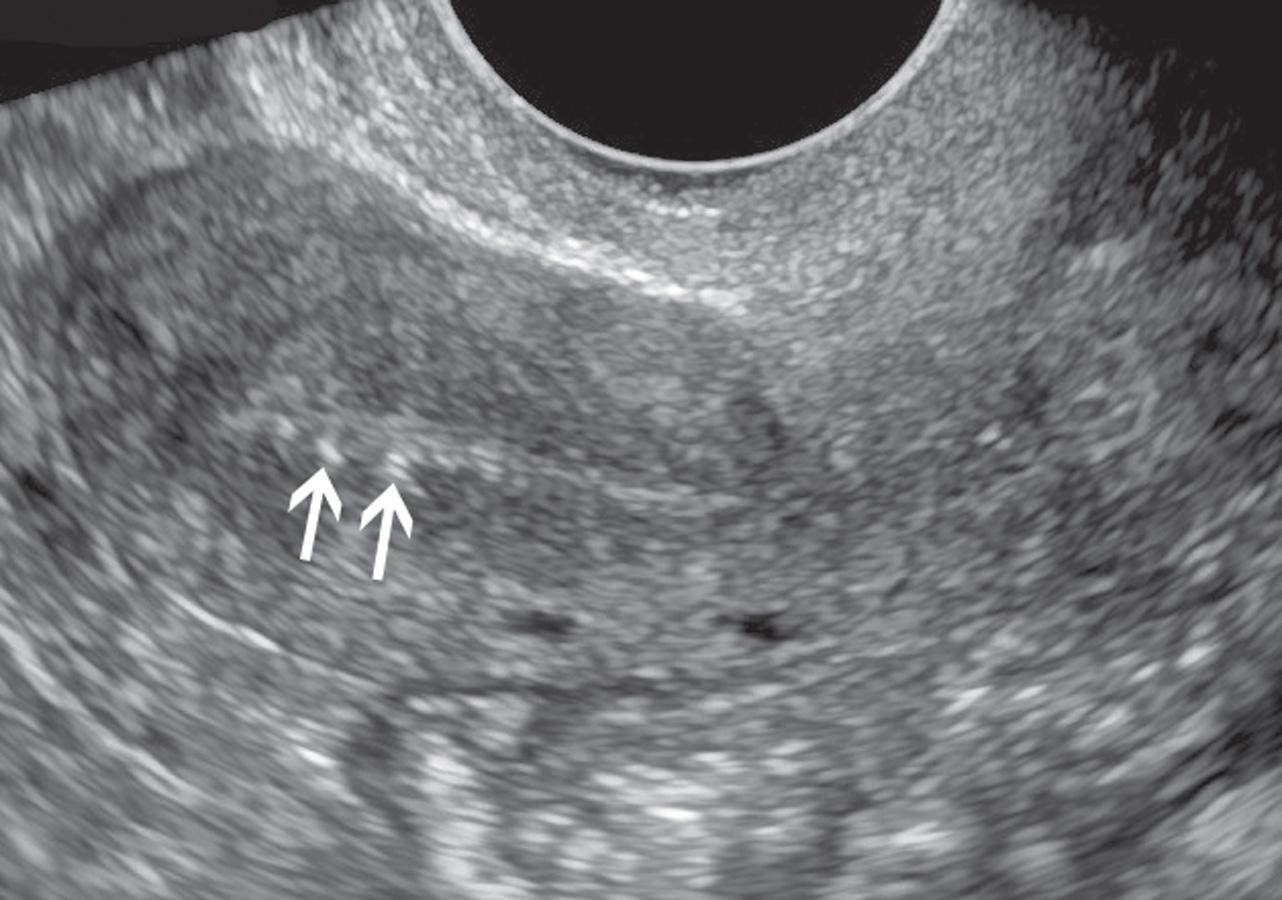
The cervix frequently contains cysts, most of which are mucous retention cysts and are commonly termed nabothian cysts. They often appear as simple cysts but may occasionally have internal echoes in the cyst fluid ( Fig. 15.7 ). Although variable in size and number, most nabothian cysts are small and of no clinical importance. Mucosal folds in the cervix, termed plicae palmatae, are more commonly seen with MRI but may occasionally be seen with TVS (see Fig. 15.7E ). Tiny echogenic foci may also be seen in the inner portion of the cervix and are likely due to punctate calcifications (see Fig. 15.7F ). These may be related to prior uterine instrumentation and are considered a benign finding. The inner part of the cervix may also appear slightly hypoechoic compared with the outer cervix and possibly simulate a mass ( Fig. 15.8 ). The uniform elongated nature of this finding should help distinguish it from a true mass.
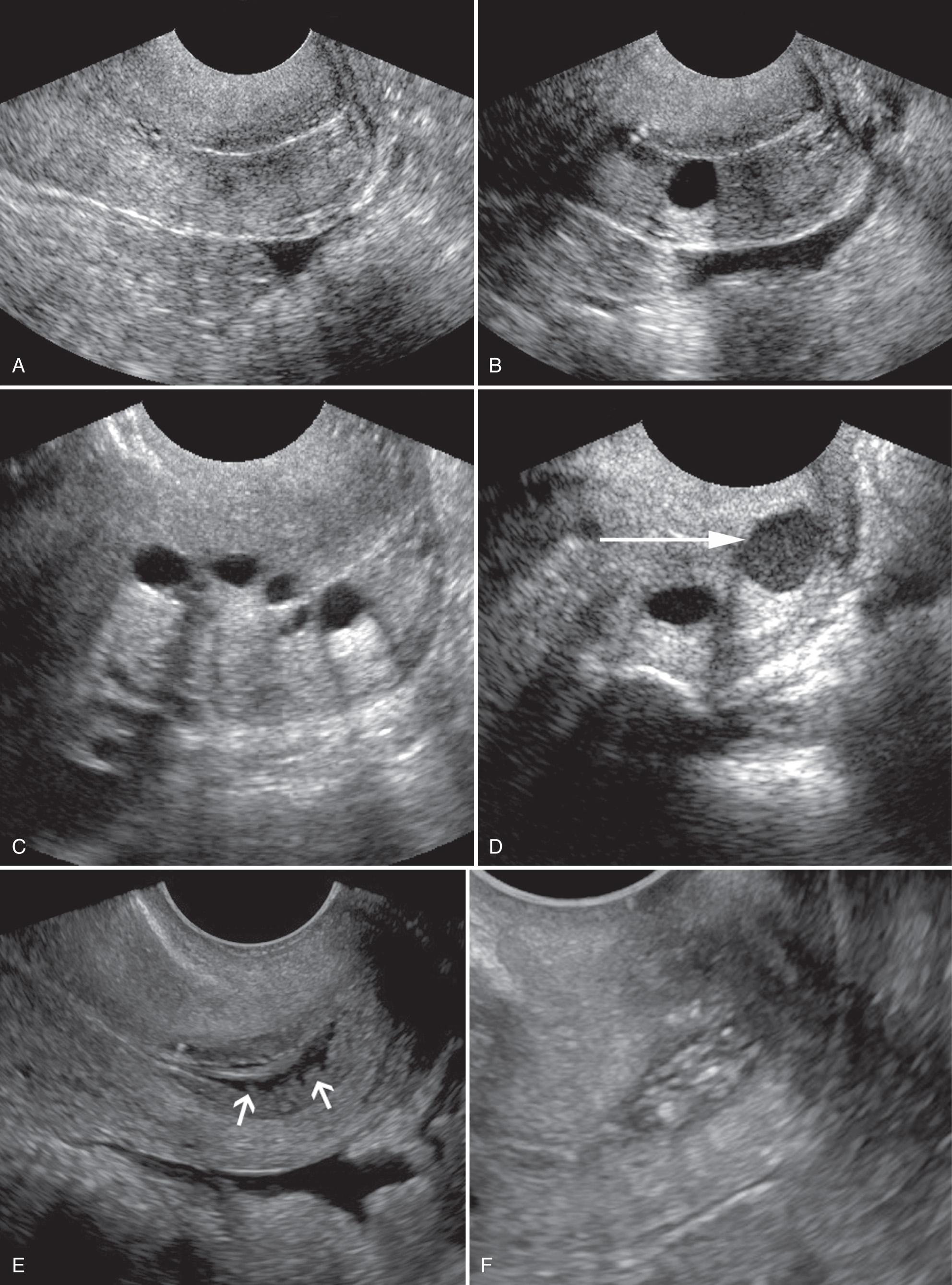
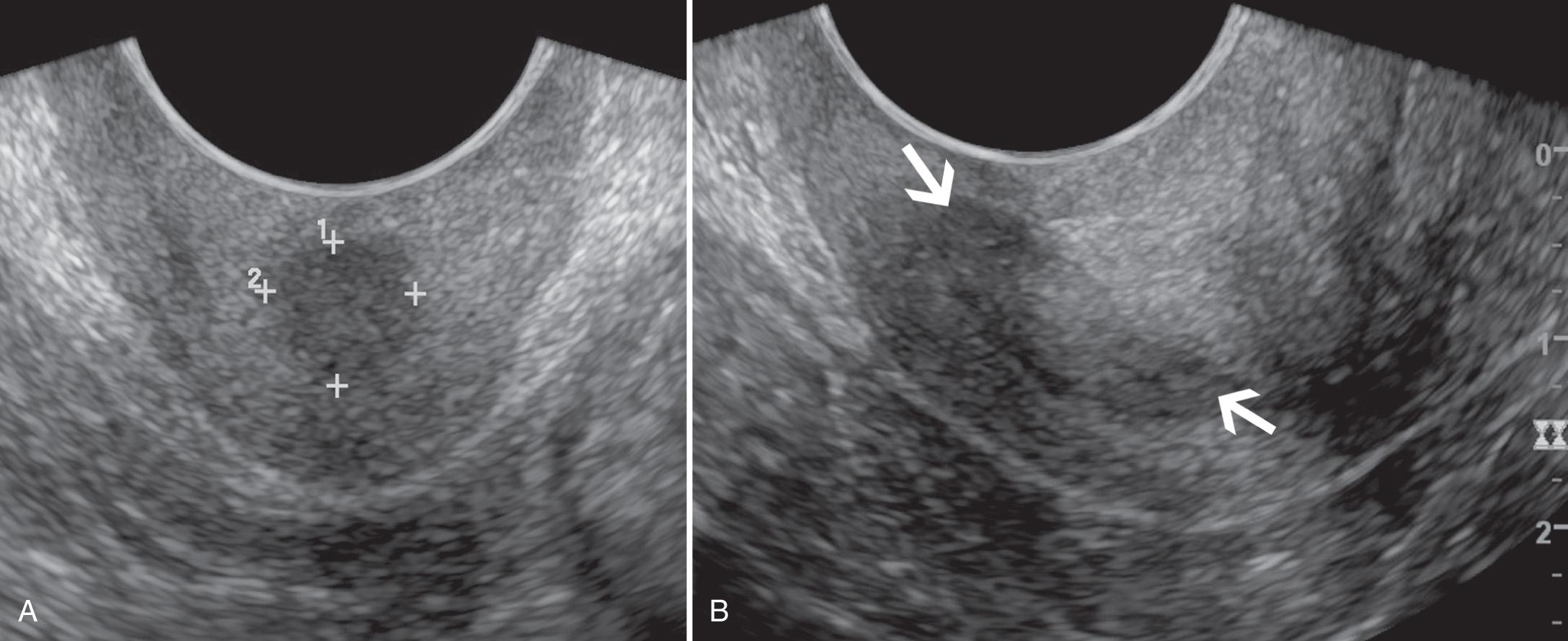
The fused caudal ends of the two müllerian (paramesonephric) ducts form the uterus, cervix, and upper two-thirds of the vagina. Fusion typically occurs in the medial portion of the ducts and proceeds in either a cephalad or a caudal direction or both. The median septum formed by the medial walls of the müllerian ducts then resorbs, leaving a single uterine cavity.
Arrested development of the müllerian ducts, failure of fusion of the müllerian ducts, and/or failure of resorption of the median septum results in variable forms of müllerian duct anomalies (MDAs). MDAs have an estimated prevalence ranging from up to 6% in the general population to up to 15% in populations with recurrent pregnancy losses. Whereas minor anomalies (arcuate uterus with just a mild fundal indentation) probably have no clinical consequence, others are associated with pregnancy loss (septate uterus) and various obstetric complications such as premature delivery (bicornuate uterus).
The anomalies are typically categorized based on their embryology and morphology, and the most commonly used classification is one from 1988 by the American Fertility Society, now known as the American Society for Reproductive Medicine ( Fig. 15.9 ). Failure of fusion of the müllerian ducts results in uterus didelphys or bicornuate uterus, and failure of resorption of the uterine septum results in a septate uterus (the most common MDA). Other anomalies may be seen in patients exposed to diethylstilbestrol (DES) in utero , although this is seen less frequently now since its use was stopped in the early 1970s. In DES exposure, sonography may demonstrate a diffuse decrease in the size of the uterus and an irregular T -shaped uterine cavity.
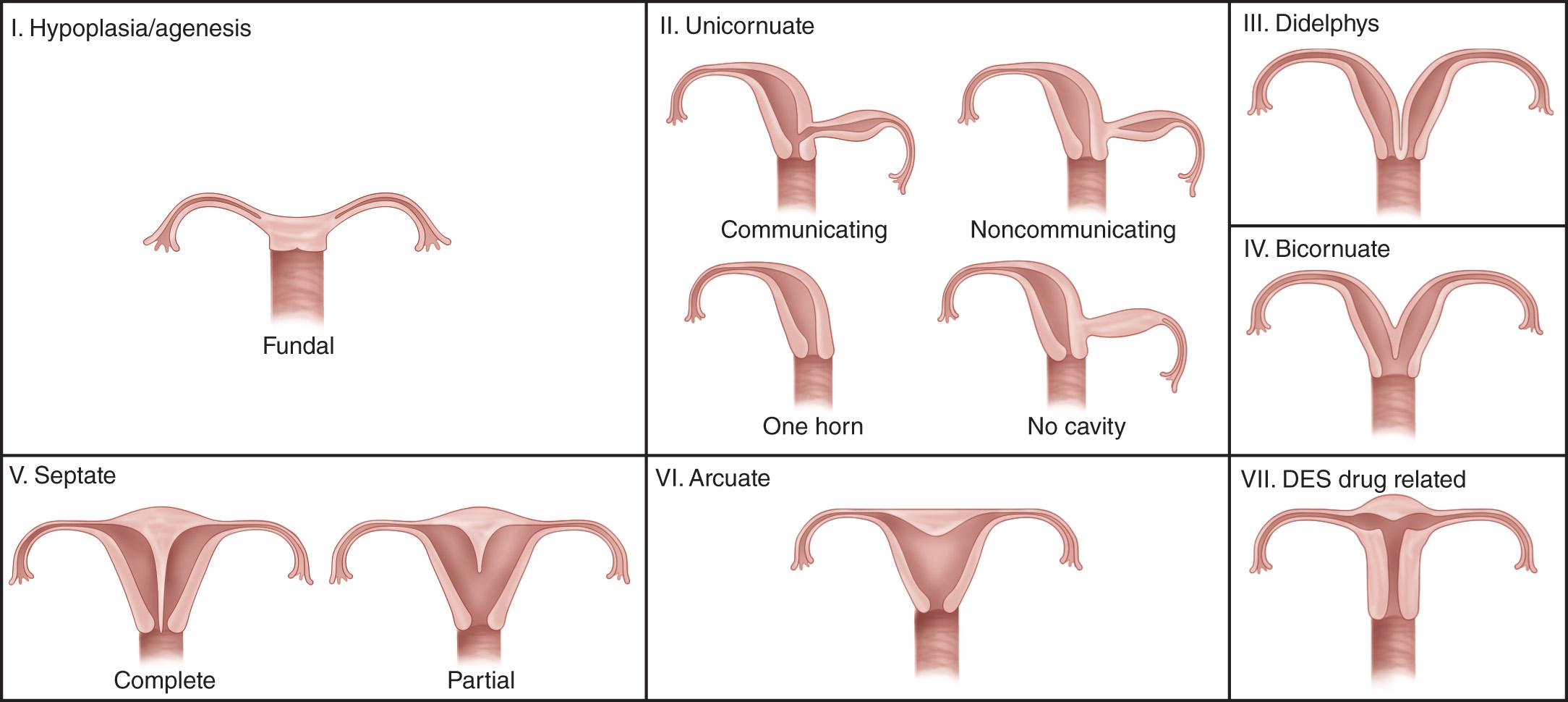
The aforementioned classification system is problematic, however, because vaginal anomalies are not included, not all anomalies fit the classification, and there are no specific imaging features defined for diagnosis. Various imaging criteria have been proposed. We will focus on the more commonly used criteria, realizing there is no clear agreement on the best criteria. Alternative classification systems of MDAs have been suggested. Some patients will have complex anomalies that do not fit neatly into classification systems; accurate description of the various components of the anomaly is important in such cases, with measurements such as fundal indentation, septal thickness, and myometrial thickness, being potentially helpful.
The coronal view of the uterus is important for many of the MDAs ( Fig. 15.10 , Videos 15.1 and ), particularly when trying to diagnose the more common anomalies such as septate uterus. One cannot usually obtain a view of the uterus in its coronal plane with two-dimensional (2-D) TVS, although occasionally one can obtain a coronal view of the uterus with TAS when there is little fluid in the urinary bladder, and the uterus is sufficiently anteflexed. In general, 3-D ultrasound is needed for determining the type of MDA. A recent meta-analysis for accuracy and diagnosis of MDAs (based on studies that predominately used the 1988 classification system ) showed that the highest degrees of mean diagnostic accuracy were, in decreasing order, as follows: 3-D ultrasound, 97.6%; SHG, 96.5%; hysterosalpingography (HSG), 86.9%; and 2-D ultrasound, 86.6%.
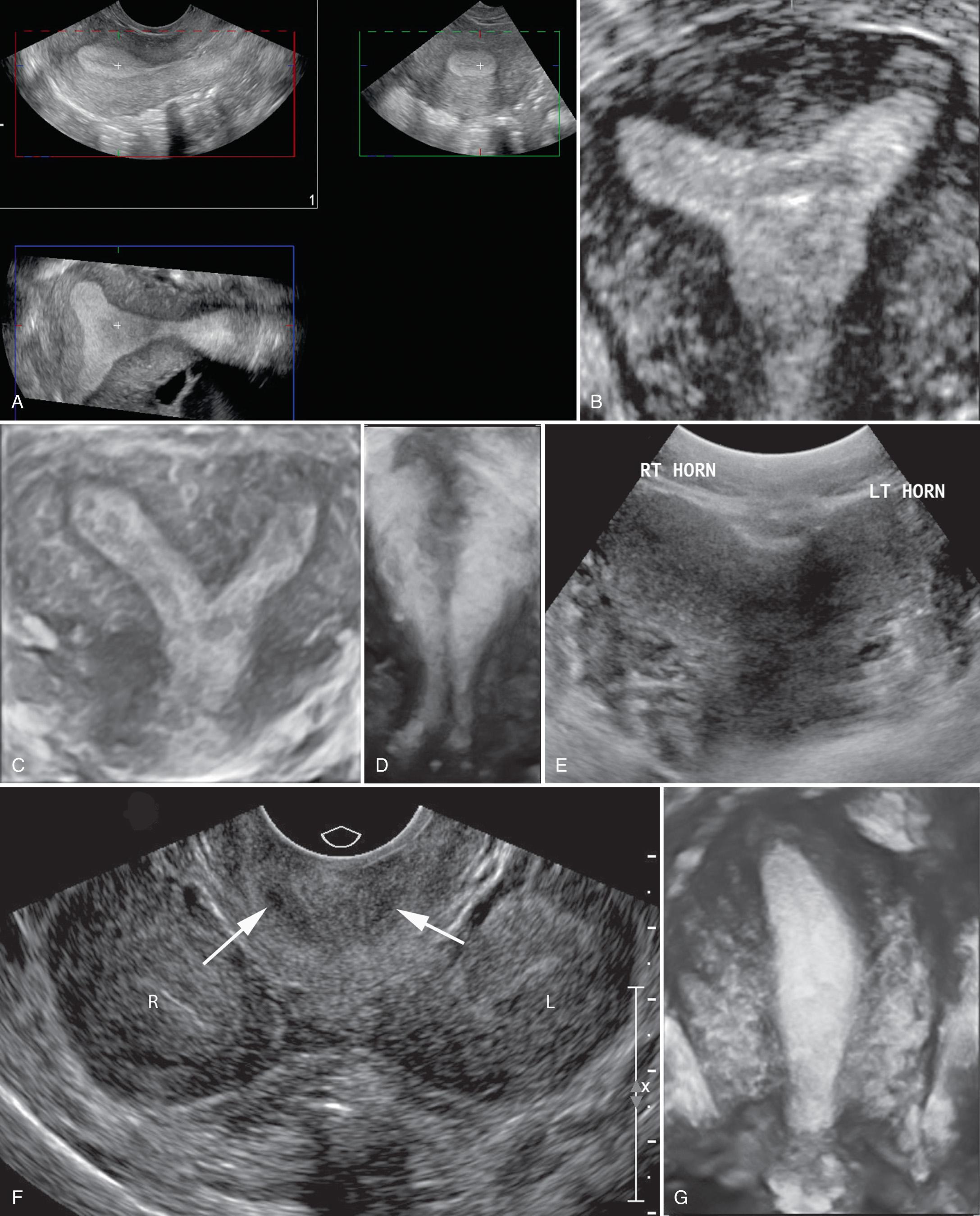
The most common distinction to be made in clinical practice is when the endometrium appears slightly divided on 2-D ultrasound and one needs to determine whether this is an arcuate, septate, or bicornuate uterus. This is an important distinction to make because (particularly for infertility patients) when the MDA is thought to have reproductive consequences, a septate uterus will in general be treated surgically (because the septum may have a poor blood supply and can contain fibrous and/or myometrial tissue and is associated with recurrent miscarriage), whereas a bicornuate uterus will in general not be treated surgically. Using the 3-D TVS reconstructed coronal view of the uterus, one should evaluate the contour of the myometrium in the fundus of the uterus. If the fundal myometrium is outwardly convex or has an inwardly concave indentation of less than 1 cm (from a reference line across the superior aspect of the myometrial edge in the two cornual regions), the distinction narrows to a septate (or subseptate) versus arcuate uterus. The term “subseptate” or “partial septate” is sometimes used when the septum does not extend all the way from the fundus to the cervix. The 1-cm fundal cleft criterion to distinguish septate (or arcuate) from bicornuate uterus is a commonly used criterion, although other methods have been suggested.
The significance of and diagnostic criteria for an arcuate uterus are unclear. Arcuate uterus refers to slight indentation of the fundal myometrium into the endometrium. There is debate about whether it is truly an anomaly or just a normal variant, and further debate about whether it has clinical importance. Part of the difficulty in sorting out these questions arises from uncertainty in what criteria one uses for the diagnosis. We are also unaware of criteria for distinguishing mild arcuate uterus from a normal uterus. Suggested criteria for diagnosis of an arcuate uterus are an angle greater than 90 degrees at the end point of the fundal indentation or a less than 1-cm indentation of myometrium into the endometrium (from a reference line across the superior aspect of the endometrial edge in the two cornual regions).
In general, if there is an indentation of greater than 1 cm in the fundal myometrium, one then needs to distinguish between a bicornuate uterus and uterus didelphys. In bicornuate uterus, the two endometrial cavities join at some point, usually just above the cervix. There can be either one cervix (bicornis unicollis) or two cervices (bicornis bicollis). In uterus didelphys, there are two separate uterine horns and two cervices. However, the distinction between a bicornuate uterus with two cervices versus uterus didelphys may be difficult, and perhaps not clinically relevant. In a newer classification system the overlap between septate and bicornuate uterus is better described ; however, septate uterus is probably overdiagnosed by these definitions.
Arrested development of one müllerian duct results in variable forms of a unicornuate uterus. In general, unicornuate uterus is easily recognized on 3-D ultrasound because the single horn configuration, sometimes referred to as “banana-shaped,” is usually obvious on the reconstructed coronal plane. The single horn configuration of the endometrium, with absence of one cornual region, is easy to overlook on 2-D ultrasound unless one pays close attention. A unicornuate uterus may be deviated to one side of the pelvis, but this uterine deviation can be overlooked on 2-D ultrasound. When a unicornuate uterus is seen, it is important to determine if there is a rudimentary horn and if that rudimentary horn contains endometrium, as such determination will typically affect management of the patient. About a third of patients with unicornuate uterus will not have a rudimentary horn. For the approximate two-thirds of patients with a unicornuate uterus who have a rudimentary horn, about half will have endometrium in the rudimentary horn. In most patients with a rudimentary horn that has endometrium, the rudimentary horn does not communicate with the other horn. These latter patients are at increased risk for endometriosis and rudimentary horn pregnancy, which has a high likelihood of rupture. Hydrometra in the rudimentary horn may be mistaken for a uterine or adnexal mass. Surgical resection of a rudimentary horn that contains endometrium, especially if noncommunicating, is often recommended. It is not clear how reliably ultrasound, whether 2-D or 3-D, can exclude the presence of a rudimentary horn because they are sometimes small and may be obscured by bowel gas. If a rudimentary horn is not seen on ultrasound, one should consider MRI to be more confident there is truly no rudimentary horn.
There are variable and often complex forms of uterine hypoplasia or agenesis. One may not be able to perform TVS in such patients, and MRI may be needed to fully define the anatomy as small uterine remnants may be present and difficult to identify sonographically. The most common form is Mayer-Rokitansy-Kuster-Hauser syndrome, with most patients having uterine and vaginal agenesis.
Vaginal septa may be transverse or longitudinal in orientation and are most commonly seen with uterus didelphys, although they can occur with other MDAs. A transverse septum may cause obstruction and result in hematocolpos or hematometrocolpos. A duplicated cervix is a component of uterus didelphys but can occur with other anomalies. Other than clearly separated cervices, it can be difficult to distinguish true cervical duplication from a cervix divided by a septum. With this in mind, in women with a double cervix it is important to evaluate the full uterine anatomy because a complete septate uterus is at least as common as uterus didelphys.
The kidneys should be evaluated in patients with MDAs because renal anomalies occur with increased frequency in such patients compared with the general population. The most common renal anomalies are absent or ectopic kidney. The most common types of MDAs to have associated renal anomalies are uterus didelphys (often with renal agenesis ipsilateral to an obstructed horn) and unicornuate uterus (usually renal agenesis ipsilateral to the side of the absent or rudimentary horn).
Uterine leiomyomas, commonly referred to as fibroids, are common benign neoplasms of the uterus. They are composed of varying amounts of smooth muscle and fibrous tissue. The lifetime prevalence of uterine leiomyomas is greater than 80% among black women and approaches 70% in white women. Some women with leiomyomas are asymptomatic but leiomyomas can cause abnormal vaginal bleeding, pain, or “bulk” symptoms such as bowel or bladder dysfunction.
Normal variant
Fibroids
Adenomyosis
Obstructed uterus
Malignancy
Endometrial cancer
Uterine sarcoma
Cervical cancer
Leiomyomas can be classified by location: submucosal (abutting the endometrium), intramural (within the myometrium) and subserosal (involving the serosal surface of the uterus). Some subserosal leiomyomas are pedunculated, with a common definition having the center of the leiomyoma outside the uterus and attached to the uterus by a stalk narrower than 50% of the diameter of the leiomyoma. Pedunculated subserosal leiomyomas may be difficult to distinguish from a solid ovarian neoplasm if the ipsilateral ovary is not identified. In such cases, it is often helpful to use color or power Doppler imaging to search for vessels connecting the leiomyoma to the uterus ( Fig. 15.11 ). Leiomyomas occasionally occur in the cervix. Submucosal leiomyomas, many of which can be treated hysteroscopically, are often subclassified into type 0 (completely within the endometrial cavity), type I (more than 50% in the endometrial cavity), and type II (less than 50% in the endometrial cavity). This distinction is important because when fibroids are more than 50% within the endometrial cavity, they can frequently be removed hysteroscopically. The location of some leiomyomas spans several of these more general groups, and a more detailed classification of leiomyoma location has been suggested. Thus when fibroids are seen to distort the endometrium, it is frequently helpful to estimate the percentage within the endometrial cavity in addition to using whatever classification system is preferred by the referring clinicians. Although TVS is often adequate when fibroids are small and/or few in number, it is important to also assess the patient with TAS. Large fibroids, fibroids located superiorly in an enlarged uterus, or pedunculated subserosal leiomyomas may be incompletely seen or entirely overlooked if only TVS is performed.
Hypoechoic or heterogeneous solid mass, occasionally hyperechoic
Round or oval shape
Distortion of external uterine contour or endometrium, depending on size and location
Attenuation or shadowing
Calcification
Cystic areas from degeneration or necrosis
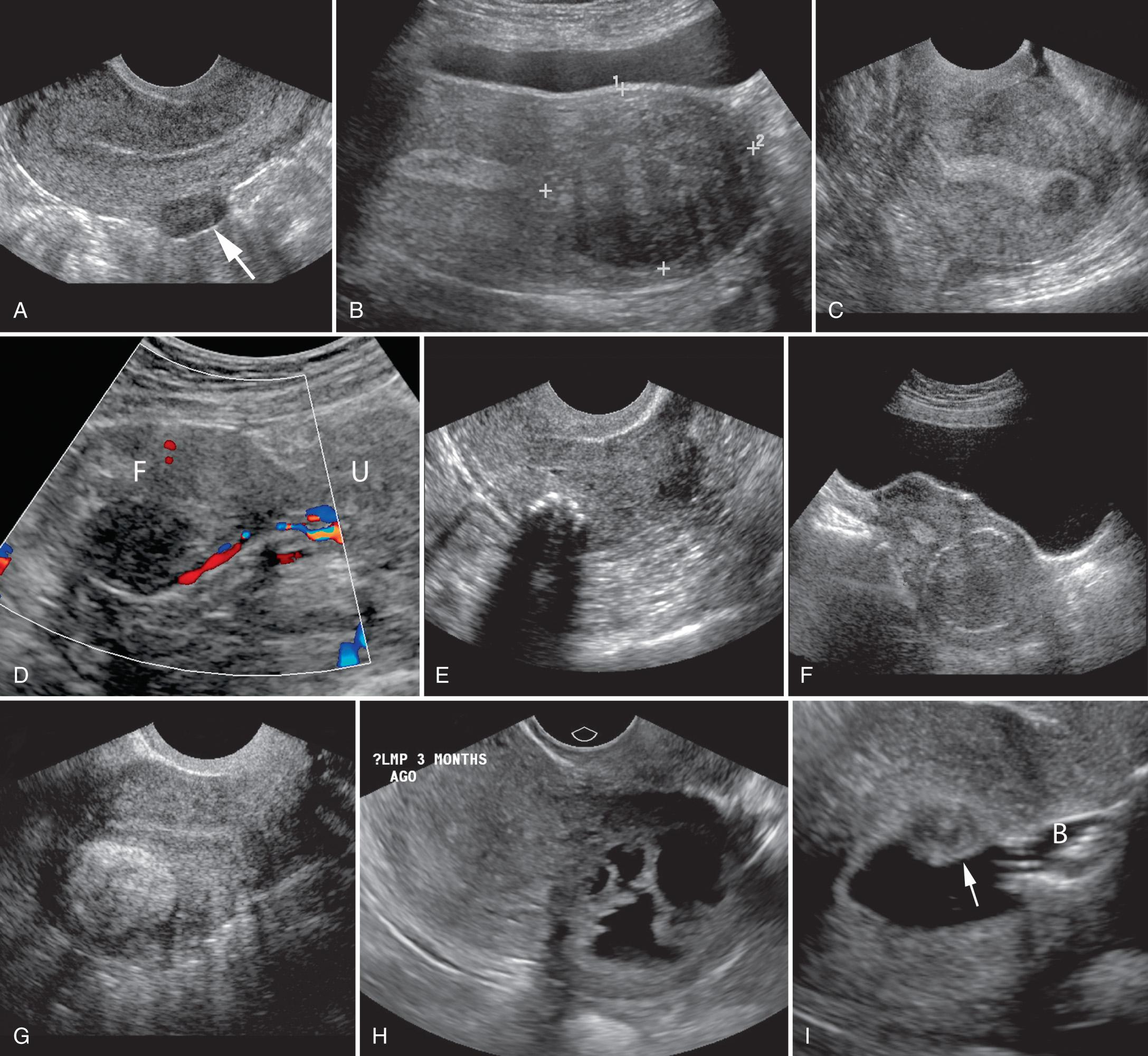
Fibroids may have variable appearances (see Fig. 15.11 , Video 15.3 ) but most often appear as well-defined, spherical to ovoid, solid masses that are hypoechoic compared with normal myometrium. They are frequently heterogeneous and tend to produce mass effect on adjacent structures depending on size and location. Leiomyomas may attenuate sound deep to the entire mass, but also commonly have bandlike areas of shadowing originating from nonhyperechoic areas within the mass, termed “refractory shadowing.” Calcification occurs in a minority of leiomyomas. The calcification is usually in one or more focal areas and has associated acoustic shadowing. Less frequently, rim calcification may occur and in general is seen after hemorrhagic degeneration or after uterine artery embolization (UAE). Occasionally, leiomyomas are isoechoic or hyperechoic compared with myometrium. When one encounters a hyperechoic leiomyoma, a lipoleiomyoma should be considered, although it is likely that not all hyperechoic leiomyomas are lipoleiomyomas. The fat in a lipoleiomyoma is probably due to adipocyte differentiation rather than a degenerative change. Lipoleiomyomas are most frequently noted in postmenopausal women and usually have a benign clinical course.
Uterine leiomyomas occasionally undergo various forms of benign degeneration. Many types of degeneration are not evident sonographically and may be better detected on MRI. Cystic spaces within a leiomyoma usually indicate cystic degeneration but may also be seen with myxoid degeneration. Hyaline, hemorrhagic, and hydropic degeneration are usually difficult to diagnose by ultrasound. Hemorrhagic degeneration may not produce any change in appearance, although homogeneity, a hyperechoic rim, and lack of detectable flow by Doppler imaging have been described. In a patient with acutely degenerating fibroid (typically during rapid growth in pregnancy or as a result of UAE), pain will usually be localized to the fibroid(s) undergoing degeneration, and thus the diagnosis can be suggested during the sonographic examination, even if the sonographic appearance of degeneration is not yet evident.
Fortunately, the vast majority of myometrial masses are due to leiomyomas. There are other uncommon forms of myometrial neoplasms, such as cellular leiomyomas and smooth muscle tumors of uncertain malignant potential (STUMPs), but we are not aware of any specific sonographic features to diagnose such entities. Rarely, leiomyomas have unusual growth patterns such as intravenous leiomyomatosis, disseminated peritoneal leiomyomatosis, benign metastasizing leiomyomas, and parasitic leiomyomas; the leiomyomas in these rare entities have a similar appearance to the more usual leiomyomas but are in vastly different locations.
After noninvasive treatment with UAE most fibroids remain hypoechoic, although cystic change or increased echogenicity occasionally occurs; diminished or absent flow on Doppler imaging is expected. Tubular hyperechoic structures thought to be due to thrombosed uterine artery branches have been described after UAE. Echogenic foci due to gas may occur in leiomyomas as a normal finding after UAE, and clinical assessment is needed to help distinguish this from a pyomyoma. Submucosal fibroids may prolapse and thus a mass may be seen in the endometrial cavity, cervix, or vagina. Little has been reported about the appearance of leiomyomas after MRI-guided focused ultrasound ablation.
Uterine sarcomas are uncommon. Although some forms of uterine sarcoma arise in the endometrium, the more common leiomyosarcomas arise in the myometrium. Risk factors for leiomyosarcoma include pelvic irradiation, tamoxifen, and rare genetic syndromes. Unfortunately, it is difficult to diagnose leiomyosarcomas by ultrasound or other imaging modalities because their appearance and growth rate overlap with the much more common leiomyomas. Other than evidence of metastasis, no currently known imaging feature is reliably predictive. Leiomyosarcomas tend to be large and heterogeneous and to have cystic change ( Fig. 15.12 ), but such changes are also common in leiomyomas. Doppler imaging has not proven reliable. Rapid growth, particularly in a postmenopausal patient, has been considered a worrisome sign for leiomyosarcomas but “rapid” is not well defined and the usefulness of rapid growth is unclear. Diagnosis of leiomyosarcoma by MRI is also challenging, although diffusion-weighted imaging may be helpful. Serum lactate dehydrogenase levels may be helpful for diagnosis of leiomyosarcoma.
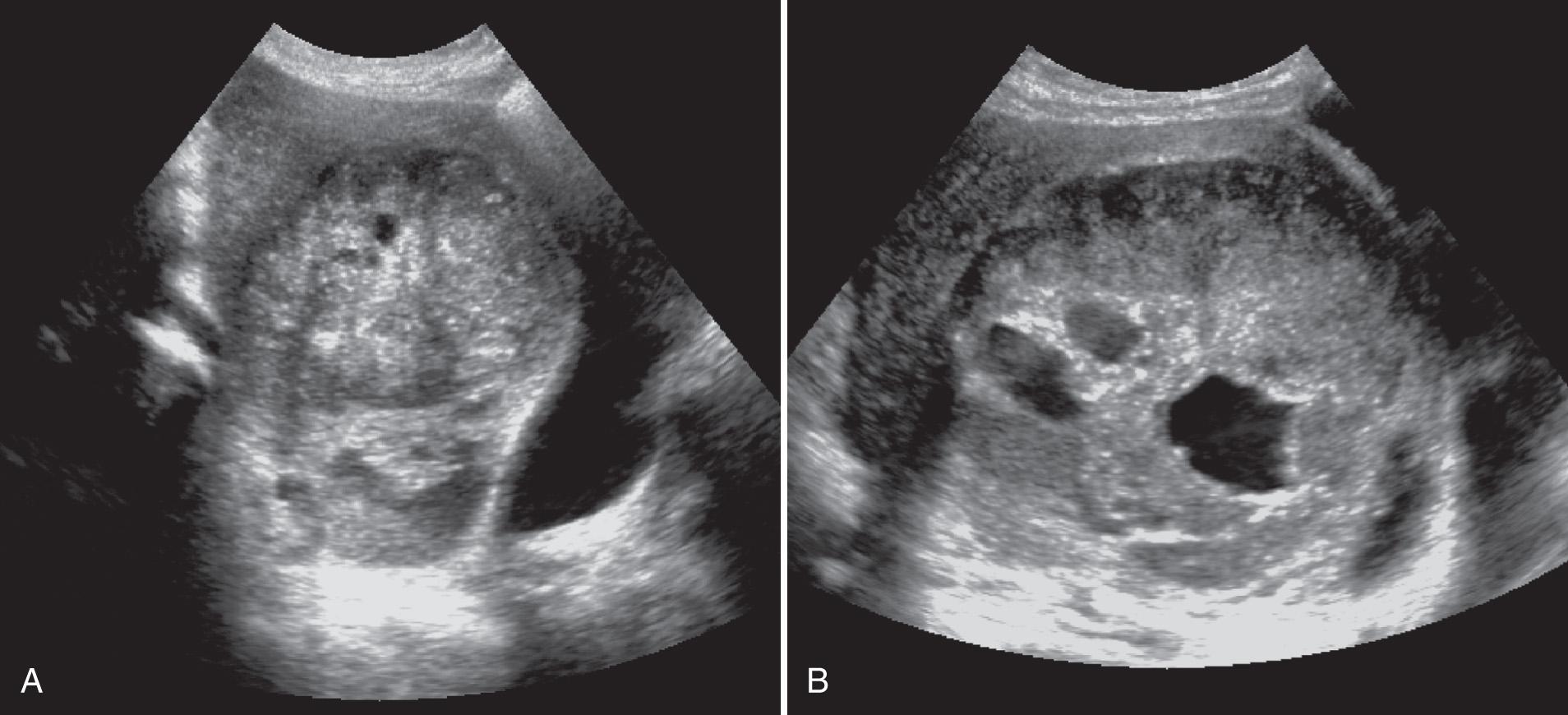
Adenomyosis is a benign condition wherein endometrial glands and stroma are present in the myometrium. In general, the histologic diagnosis of adenomyosis requires the presence of endometrial glands or stroma to be located more than 2.5 or 3 mm away from the outer edge of the endometrium. It may cause pain, abnormal vaginal bleeding, or infertility, although some patients are asymptomatic. The prevalence of adenomyosis is uncertain; there are widely varying estimates from 5% to 70%. Adenomyosis and endometriosis may coexist; 22% to 49% of women with endometriosis are reported to also have adenomyosis.
Diffuse, sometimes globular-shaped, uterine enlargement
Diffusely heterogeneous myometrium
Asymmetrical thickening of myometrium
Indistinct hypoechoic areas
Myometrial cysts
Poor definition of endometrial-myometrial border
Focal tenderness elicited when scanning over the uterus
Subendometrial echogenic linear striations
Subendometrial echogenic nodules
Adenomyosis most often affects the myometrium diffusely. Occasionally it occurs in a focal form (sometimes called “focal adenomyosis” when involving only part of the myometrium or an “adenomyoma” when more distinct) and rarely can take the form of a cyst (“cystic adenomyoma”). Ultrasound is an accurate diagnostic test for adenomyosis, although about 9% of affected patients have normal ultrasound findings. Sonographic findings that are suggestive of diffuse adenomyosis include enlarged globular shape of the uterus, heterogeneous myometrium, asymmetrical thickening of the myometrium, indistinct interface between the endometrium and myometrium, myometrial cysts, and echogenic striations or nodules in the myometrium ( Fig. 15.13 , Video 15.4 ). Heterogeneity of the myometrium has been reported as the most common finding but has poor specificity ; this may be related to the subjective nature of determining heterogeneity. Thus it is important to look for other sonographic features when one identifies a heterogeneous myometrium. Echogenic linear striations, myometrial cysts, globular uterine shape, and asymmetrical myometrial thickness have all been reported to have high specificity. Although not generally performed to diagnose adenomyosis, SHG may show communication between the lesions of adenomyosis and the endometrial cavity. Rarely, adenomyosis can appear as an isolated cystic mass, larger than the small myometrial cysts typically seen in adenomyosis, and has been termed a juvenile cystic adenomyoma. However, these isolated larger myometrial cysts may instead represent a rare, recently proposed type of MDA, an accessory and cavitated uterine mass (ACUM). Specific criteria to diagnose ACUM have been proposed.
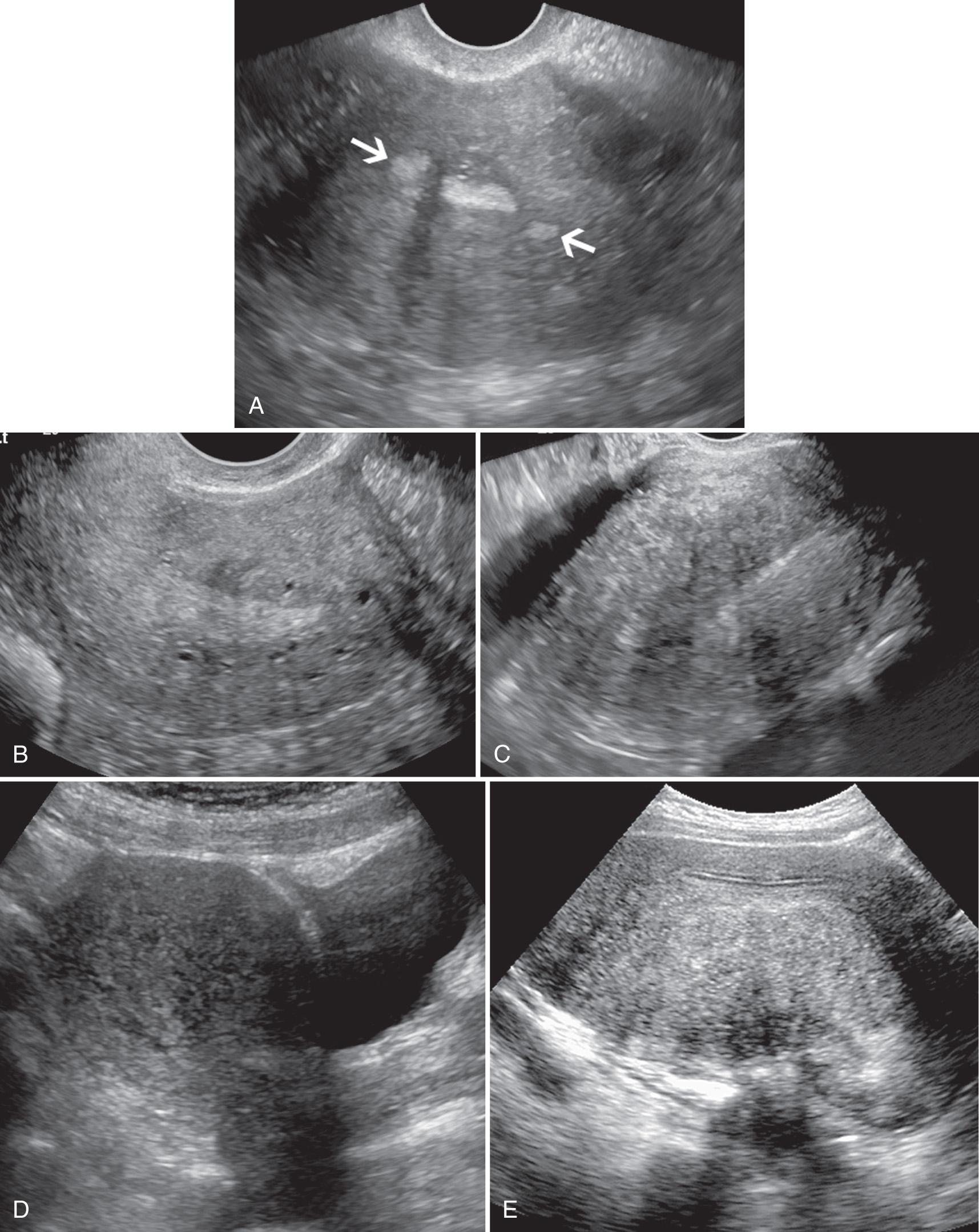
Adenomyosis and leiomyomas often coexist; 15% to 57% of women with leiomyomas are reported to also have adenomyosis in surgical series. It can sometimes be difficult to distinguish these two entities, or determine if both are present, by ultrasound. Focal adenomyosis is usually the form most difficult to distinguish from leiomyomas. Distinct borders are typical of leiomyomas, whereas indistinct borders suggest adenomyosis. It has been suggested that color or power Doppler may be helpful in making the distinction, with adenomyosis tending to have more central vascularity and leiomyomas tending to have mostly peripheral vascularity. However, the reliability of Doppler findings to make this distinction has not been adequately evaluated. In patients in whom one is uncertain whether the findings represent adenomyosis or leiomyomas or both (when making this distinction is important for clinical care), MRI is helpful.
Although adenomyosis is usually considered to occur mostly in premenopausal women, it can be seen in postmenopausal women. Women with breast cancer who are treated with tamoxifen have a higher incidence of adenomyosis. It may be that the estrogen agonist effects of tamoxifen on endometrial tissue cause adenomyosis or reactivate preexisting adenomyosis.
Occasionally one may encounter one or a few small cysts at the endometrial/myometrial border, in the absence of other sonographic findings of adenomyosis. The significance of such an isolated finding is not clear. As mentioned previously, the histologic diagnosis of adenomyosis generally requires the presence of endometrial glands or stroma to be located more than 2.5 or 3 mm away from the outer edge of the endometrium. Thus we would be reluctant to diagnose adenomyosis based solely on one or a few small cysts at the endometrial/myometrial border, in the absence of other sonographic features of adenomyosis.
After a supracervical hysterectomy, one expects to see most or all of the cervix remaining, and should not mistake the remaining cervix for a mass ( Fig. 15.14A ). Occasionally one may observe a cervical polyp on ultrasound ( Fig. 15.14B ), although many of these are evident on clinical examination. Small cervical polyps may be difficult to identify sonographically unless there is surrounding fluid. At times, endometrial polyps (or endocavitary leiomyomas) will prolapse into the cervix. The diagnosis can be made based on visualization of the vascular stalk leading to the prolapsed lesion in the endocervical canal ( Fig. 15.14C–D , Video 15.5 ).
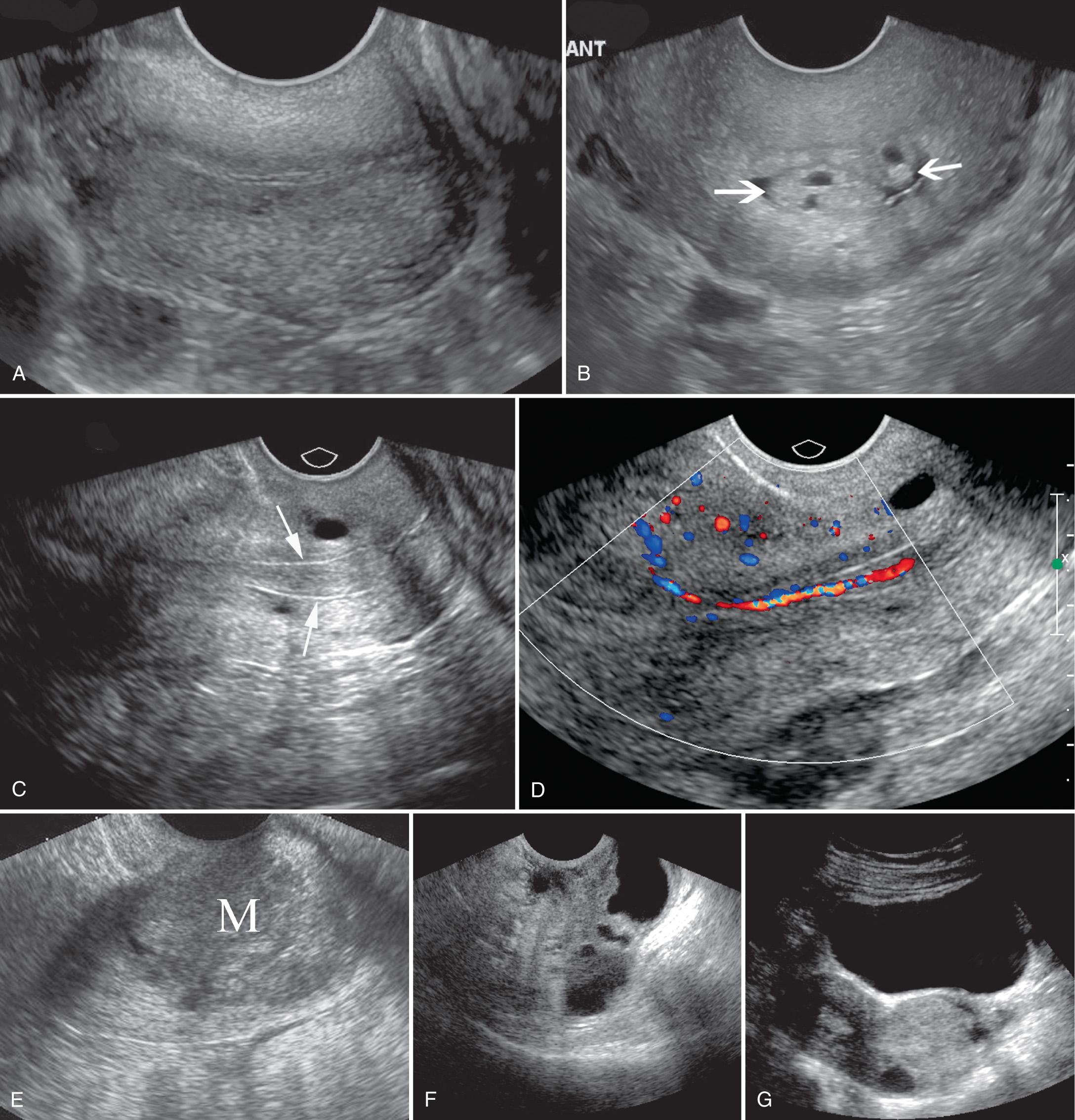
Cervical carcinoma is usually diagnosed without imaging, but occasionally one may incidentally encounter a patient with cervical carcinoma. Cervical carcinoma typically appears as a heterogeneously hypoechoic solid mass ( Fig. 15.14E ). It may be difficult to distinguish from a leiomyoma by ultrasound, although increased vascularity on Doppler imaging has been described.
Adenoma malignum, also termed minimal deviation adenocarcinoma, is an uncommon type of cervical carcinoma that has been associated with Peutz-Jeghers syndrome. Watery vaginal discharge has been described as a common symptom. Sonographically these are most often multiloculated cystic masses with a solid component or completely solid masses ( Fig. 15.14F–G ). Multiple adjacent nabothian cysts might simulate this lesion, but when a solid component is present, particularly with flow by Doppler imaging, one should consider this uncommon neoplasm.
Because of its improved resolution, TVS is better able to image and depict subtle abnormalities within the endometrium and clearly define the endometrial/myometrial interface than is TAS. Knowledge of the varied normal sonographic appearances of the endometrium that vary with respect to time of the menstrual cycle, patient menopausal status, and hormone use allows for recognition of pathologic conditions manifested by endometrial thickening because the expected upper limits of normal thickness will vary with these factors. Many endometrial pathologies, such as hyperplasia, polyps, and carcinoma, can cause abnormal bleeding. Abnormal bleeding can be due to abnormally heavy menstrual periods at the expected time of the menstrual cycle (menorrhagia, for example due to fibroids or adenomyosis), abnormal bleeding at an unexpected time of the cycle (metrorrhagia), or both (menometrorrhagia).
Pregnancy
Systemic disease (liver disease, blood dyscrasias)
Endometrial polyps or hyperplasia
Endometrial cancer
Intrauterine device (IUD) malposition
Cesarean section scar defect
Although heavy vaginal bleeding is typically from a myometrial or endometrial cause, abnormal bleeding can at times arise from other sources such as bleeding from the vulva or vagina (lacerations, infection, or cancer), from the cervix (polyps, fibroids, or cancer), from the fallopian tubes (salpingitis, tumors, or tubal pregnancy), or be secondary to ovarian pathology (estrogen-producing tumor, cancer, functional ovarian cysts).
SHG can be of great value in further evaluating the abnormally thickened endometrium. SHG can distinguish between focal and diffuse endometrial abnormalities and help guide further management. If the abnormality is diffuse, a blind, nondirected biopsy can be done, but a focal process, such as a polyp, typically requires hysteroscopy with directed biopsy or excision. SHG may also be able to help distinguish benign from malignant endometrial processes. Patients with endometrial cancer may have poorly distensible endometrial cavities.
Pregnancy
Retained products of conception
Fibroids (submucosal or intracavitary)
Endometritis
Adhesions
Hyperplasia
Polyps
Cancer
Become a Clinical Tree membership for Full access and enjoy Unlimited articles
If you are a member. Log in here